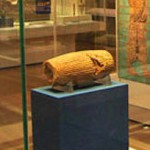By: Kristina Killgrove*
 Numerous legends of the mummy’s curse are whispered in archaeological circles, most without any substance behind them, but a team of Chilean researchers may have just discovered evidence to back it up: toxic red pigment on the clothing of two ancient maiden mummies that could cause mercury poisoning in those who study the dead.
Numerous legends of the mummy’s curse are whispered in archaeological circles, most without any substance behind them, but a team of Chilean researchers may have just discovered evidence to back it up: toxic red pigment on the clothing of two ancient maiden mummies that could cause mercury poisoning in those who study the dead.
In a new article just out in the journal Archaeometry, a research team led by Bernardo Arriaza of the University of Tarapacá has identified the presence of a red mineral in the burial of two young women — ages 9 and 18 — at the site of Cerro Esmeralda in the city of Iquique in northern Chile. Dating to around 1399-1475 AD, the girls were found to be finely dressed, with a number of silver ornaments and ceramic vessels.
Based on the quantity and quality of these burial goods, the researchers hypothesize that this might have been a ritualized human sacrifice called capacocha carried out by the Inca state. “Capacocha sacrifices,” Arriaza and colleagues explain in their paper, “were performed in commemoration of historical events in the life of the Inca emperor or in response to natural catastrophes.” Interestingly, in the case of this burial at Iquique, it “was found at a lower elevation than many other capacocha sacrifices reported in the literature, which are normally found at higher elevations.”
Even more odd than the location of this burial was the presence of a bright red powder in one of the textiles of the mummies. Red was a very popular color and prized by people in the ancient Andes for millennia; however, the raw material used to create it was most often an iron oxide like hematite because it was easily found in geological deposits. It wasn’t hematite, though, that the researchers found on these mummy maidens.
Arriaza and colleagues instead report that “the new chemical analyses that we obtained showed that cinnabar was present in the clothes of the Cerro Esmeralda mummies.” Unlike hematite, from which we can extract inert iron, cinnabar is a mineral that contains abundant amounts of mercury. “This toxic material is a special and foreign funerary offering in northern Chile,” the archaeologists note, because it almost certainly came from the Huancavelica mine just north of Lima, Peru, over one thousand miles away from where the mummies were discovered.
he Incas are known to have used cinnabar in prestigious and elite social contexts, which suggests to the researchers that the Cerro Esmeralda mummies and their burial were culturally significant. This sacrifice may have been made for political reasons, to bring the arid region of northern Chile under the powerful state forces of the Inca Empire.
But the reasons for the use of cinnabar rather than hematite are not completely clear. Arriaza and colleagues suggest that the mineral was simply popular, as it was with the Romans and ancient Egyptians, and the elite often painted their faces with it. But they also suggest that the Inca may have know of cinnabar’s toxic properties, raising the question “of whether cinnabar was sprinkled to protect the burial from grave robbers.”
Since the archaeologists did not expect to find cinnabar in a burial so far from the nearest known mine, they caution others to be careful in handling artifacts and human remains with red pigments. “Very few archaeological studies have specifically addressed the use of toxic materials in antiquity” and the consequences for modern researchers, Arriaza told me by email. He and his colleagues also write that “archaeologists need to be aware that beautiful red cinnabar contains mercury, posing hidden health risks. It may cause a range of health problems affecting the nervous and muscular systems and the gastrointestinal tract, among others, and even death in cases of extreme exposure.”
While the mummy’s curse has never been proven in the context of ancient Egyptian burials, it is clear that archaeologists need to be extra careful when recovering evidence of the past, because it is not always obvious what toxic materials lurk under the dirt.















